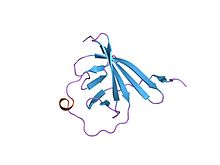In molecular biology, TCL-1/MTCP-1 is a protein domain found in proteins encoded for by two related protooncogenes, other words by genes that help promote cancer. They are, T-cell leukemia/lymphoma protein 1A TCL1A encoded by oncogene TCL-1 SWISSPROT and Protein p13 MTCP-1 encoded by MTCP-1 SWISSPROT.
| TCL1_MTCP1 | |||||||||
|---|---|---|---|---|---|---|---|---|---|
 crystal structure of p14tcl1, an oncogene product involved in t-cell prolymphocytic leukemia, reveals a novel b-barrel topology | |||||||||
| Identifiers | |||||||||
| Symbol | TCL1_MTCP1 | ||||||||
| Pfam | PF01840 | ||||||||
| InterPro | IPR004832 | ||||||||
| SCOP2 | 1jsg / SCOPe / SUPFAM | ||||||||
| |||||||||
These are overexpressed in T cell prolymphocytic leukemias as a result of chromosomal rearrangements that involve the translocation of one T cell receptor gene to either chromosome 14q32 or Xq28.[1]
Function
editEnhances the phosphorylation and activation of Akt. Once Akt is activated this will in turn trigger cell survival. Further more it helps to stabilise mitochondrial membrane potential.[2][3]
Structure
editThis protein exists as a homodimer. It interacts with AKT1, AKT2 and AKT3 via the PH protein domain. It interacts with PNPT1; the interaction has no effect on PNPT1 exonuclease activity.
References
edit- ^ Fu ZQ, Du Bois GC, Song SP, Kulikovskaya I, Virgilio L, Rothstein JL, Croce CM, Weber IT, Harrison RW (March 1998). "Crystal structure of MTCP-1: implications for role of TCL-1 and MTCP-1 in T cell malignancies". Proc. Natl. Acad. Sci. U.S.A. 95 (7): 3413–8. Bibcode:1998PNAS...95.3413F. doi:10.1073/pnas.95.7.3413. PMC 19850. PMID 9520380.
- ^ Pekarsky Y, Koval A, Hallas C, Bichi R, Tresini M, Malstrom S, et al. (2000). "Tcl1 enhances Akt kinase activity and mediates its nuclear translocation". Proc Natl Acad Sci U S A. 97 (7): 3028–33. doi:10.1073/pnas.040557697. PMC 16186. PMID 10716693.
- ^ Laine J, Künstle G, Obata T, Sha M, Noguchi M (2000). "The protooncogene TCL1 is an Akt kinase coactivator". Mol Cell. 6 (2): 395–407. doi:10.1016/S1097-2765(00)00039-3. PMID 10983986.